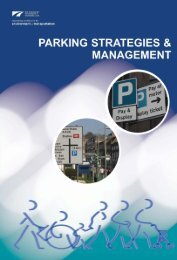Level 2 and 3 Diploma in Business Support (4475-12/13)
Level 2 and 3 Diploma in Business Support (4475-12/13)
Level 2 and 3 Diploma in Business Support (4475-12/13)
Create successful ePaper yourself
Turn your PDF publications into a flip-book with our unique Google optimized e-Paper software.
• Mailshots<br />
• Promotional videos<br />
• Newspaper (national <strong>and</strong> local) advertisements<br />
• Television advertisements<br />
• Local/national radio advertisements.<br />
1.7 The c<strong>and</strong>idate will demonstrate they can compare the factors that <strong>in</strong>fluence organisations to<br />
select a range of promotional methods by identify<strong>in</strong>g their strengths <strong>and</strong> weaknesses <strong>in</strong> relation<br />
to cost, market penetration, method of communication <strong>and</strong> chose the most appropriate giv<strong>in</strong>g<br />
reasons for the choice.<br />
Outcome 2 Be able to demonstrate how to meet customer needs <strong>and</strong><br />
expectations<br />
2.1 The c<strong>and</strong>idate will be able to identify how customers demonstrate their own <strong>in</strong>dividual needs<br />
<strong>and</strong> expectations identify<strong>in</strong>g the service customers th<strong>in</strong>k they ought to have. They should also<br />
underst<strong>and</strong> how expectations are formed by what people hear <strong>and</strong> see, what customers read <strong>in</strong><br />
advertisements, catalogues, brochures, etc; what happens dur<strong>in</strong>g the customer experience <strong>and</strong><br />
what has happened to them <strong>in</strong> other customer service experiences.<br />
2.2 Some customers have special requirements eg are angry, confused, hear<strong>in</strong>g impaired, mobility<br />
impaired, sight impaired <strong>and</strong> these special requirements should be identified <strong>and</strong> their needs <strong>and</strong><br />
expectations addressed.<br />
2.3 The c<strong>and</strong>idate should identify how they can adapt methods of communication <strong>and</strong> their<br />
behaviour to meet the <strong>in</strong>dividual needs of a range of customers eg those with language<br />
difficulties, health issues, different age groups, cultural differences, those with learn<strong>in</strong>g<br />
difficulties. It is always necessary to communicate <strong>in</strong> a clear, polite <strong>and</strong> confident way eg where<br />
there are language difficulties it may require that the service deliverer talks more slowly, clearly<br />
<strong>and</strong> without the use of jargon. The service deliverer should recognise they need to treat the<br />
customer with respect at all times <strong>and</strong> work with the <strong>in</strong>dividual to meet their needs.<br />
2.4 The c<strong>and</strong>idate should identify that there are various ways of check<strong>in</strong>g customer satisfaction<br />
through <strong>in</strong>formal feedback eg ask<strong>in</strong>g the customers or not<strong>in</strong>g feedback given by customers or<br />
through formal feedback eg questionnaires, surveys etc. Customer satisfaction could also be<br />
checked through sales figures, compla<strong>in</strong>t records etc.<br />
2.5 Build<strong>in</strong>g a strong reputation leads to customer loyalty. Hav<strong>in</strong>g a poor reputation leads to loss of<br />
bus<strong>in</strong>ess <strong>and</strong> a downturn <strong>in</strong> profits. A strong reputation means that an organisation has to attract<br />
customers to use its products or services, put th<strong>in</strong>gs right if they go wrong, create a positive<br />
impression <strong>and</strong> change its reputation over time. To improve its reputation an organisation has to<br />
listen to its customers <strong>and</strong> meet their needs <strong>and</strong> expectations.<br />
Outcome 3 Be able to communicate effectively with customers<br />
3.1 Different methods of communication are used <strong>in</strong> organisations eg<br />
• Face-to-face<br />
• Written communication eg letter, email<br />
• Telephone <strong>and</strong> text<br />
The c<strong>and</strong>idate will be required to use some or all of the different methods of communication <strong>and</strong><br />
ensure they do so effectively.<br />
Face-to-face – is about eye contact <strong>and</strong> active listen<strong>in</strong>g. ‘Normal’ eye contact may differ across<br />
cultures; ‘active listen<strong>in</strong>g is about head nodd<strong>in</strong>g, gestures <strong>and</strong> repeat<strong>in</strong>g back phrases that are<br />
heard <strong>and</strong> confirmation of underst<strong>and</strong><strong>in</strong>g.<br />
100 <strong>Level</strong> 2 <strong>and</strong> 3 <strong>Diploma</strong> <strong>in</strong> Bus<strong>in</strong>ess <strong>Support</strong> (<strong>4475</strong>-<strong>12</strong>/<strong>13</strong>)







